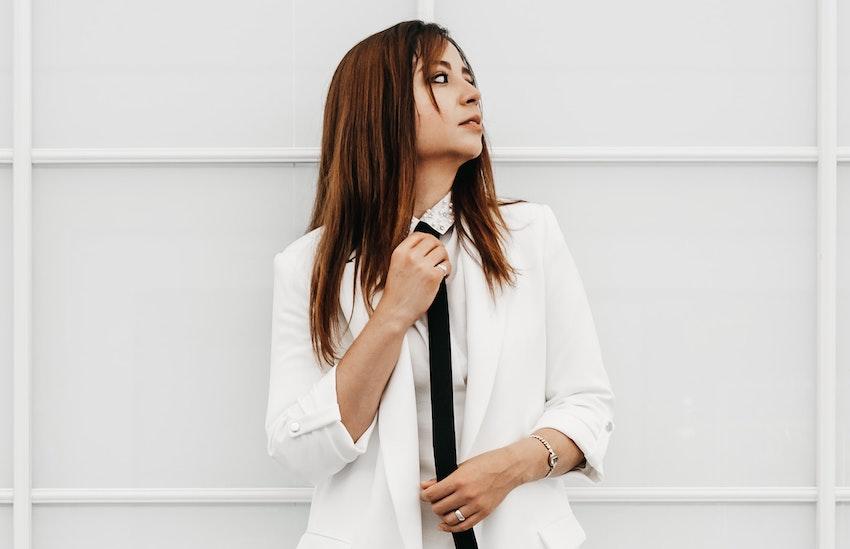What to Wear to Appear More ‘Trustworthy’ and ‘Authentic’ in Zoom Meetings
Published: Jul 01, 2020

Since Covid-19 hit, video conferencing has been the go-to way to conduct business meetings and job interviews. And according to a new Quantified Communications survey, the results of which were recently published in the Harvard Business Review, video conferencing will be here to stay.
Administered to 465 professionals, the survey found that 86 percent of respondents are “satisfied” with their video meetings, and 70 percent anticipate using video conferencing apps “the same amount as today or more, even after social distancing guidelines are lifted.”
In addition, the survey found that, in video meetings, respondents receive strong impressions from their colleagues’ attire and backgrounds. To that end, below are some of the survey’s sartorial and aesthetic findings, which will help you the next time you’re preparing to Zoom, Skype, or Google Meet for work.
Wearing neutral colors will make you appear more “authentic” and “trustworthy,” and more like an “expert”
According to the survey, 56 percent said neutral colors—white, beige, gray, black, brown, khaki, and navy—make someone appear more “authentic” vs. 30 percent who said bright colors do and 14 percent who said patterns (like plaids and stripes) do. The results are similar when it comes to the colors that make someone appear “trustworthy,” as 49 percent said neutral colors make someone look more “trustworthy” vs. 36 percent who said bright colors do and 15 percent who said patterns do.
Meanwhile, if you want to look the part of an “expert,” you most definitely want to dress in neutrals, as 74 percent said neutral colors makes someone appear like they have expertise. Compare that to 18 percent who said bright colors equals expertise, and only 8 percent who equated patterned clothing with expertise.
However, if you want to look “innovative,” it doesn’t seem to matter what you wear, as 34 percent said patterns make someone look more innovative, 33 percent said bright colors, and 33 percent said neutrals.
The overall takeaway here is less flash is more—except when it comes to wanting to exude creativity. Which is to say, for optimal authenticity, trustworthiness, and expertise, leave the reds, yellows, greens, and oranges in the closet. But if you’re looking to show off your innovative side, wear whatever color you like.
Wearing business casual attire will make you look more “authentic,” “trustworthy,” and “innovative,” but formal attire will make you look like more of an “expert”
When it comes to attire style—casual, business casual, or business formal—you’ll want to wear business casual in your video meetings to look “authentic,” “trustworthy,” and “innovative.” Almost half (49 percent) said business casual will make you appear more “authentic” vs. 27 percent who equated authenticity with business formal and 26 percent who equated it with casual attire. The percentages were similar when it came to looking “trustworthy” and “innovative.”
However, if you’re going for an “expert” look, put on a suit. More than two out of three people surveyed (67 percent) equated expertise with business formal vs. 26 percent who equated it with business casual and just 7 percent who said casual equaled expertise.
There are two takeaways here. One, business casual is the way to go for most of your video chat needs, except when you want to be seen as an “expert” in a certain area or field. And two, there’s almost no reason to dress casually. So keep the t-shirts in your drawer for your post-chat jog.
Showing the actual room you’re in—as opposed to a solid-color wall or virtual scenic photo in the background—will make you look more “authentic” and “trustworthy,” and more like an “expert”
When you choose what to allow your video meeting partners to see behind you, it’ll benefit you to let them see the room you’re in, instead of just a plain wall or virtual scenic background (such as a photo of a pristine beach or famous building). Nearly two out of three (65 percent) of those surveyed said showing the actual room will make you appear more “authentic,” 73 percent said it will make you look more “trustworthy,” and 52 percent said it will make you look like more of an “expert.”
However, 43 percent said only showing a solid-colored wall makes you look more “innovative” vs 40 percent who said showing the actual room would. Meanwhile, virtual scenic backgrounds scored low in all categories: 4 percent in authenticity and expertise, 5 percent in trustworthiness, and 17 percent in innovation.
And so, the takeaway here is this: Go the extra mile before your next video meeting. Clean your room, straighten your bookshelves, and level your paintings. Then, during your meeting, let your colleagues check out your surroundings. That is, unless you want to look like an innovator, in which case it’s fine to leave your laundry on the floor and show your colleagues nothing but a plain, white wall.
